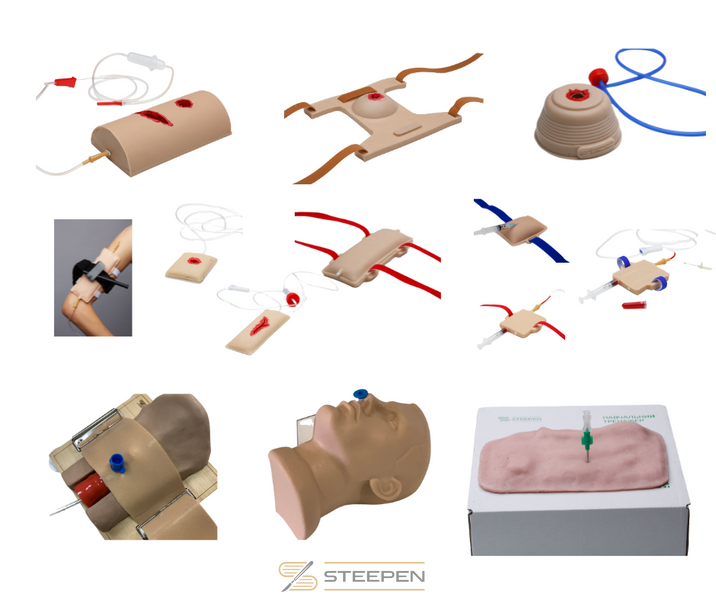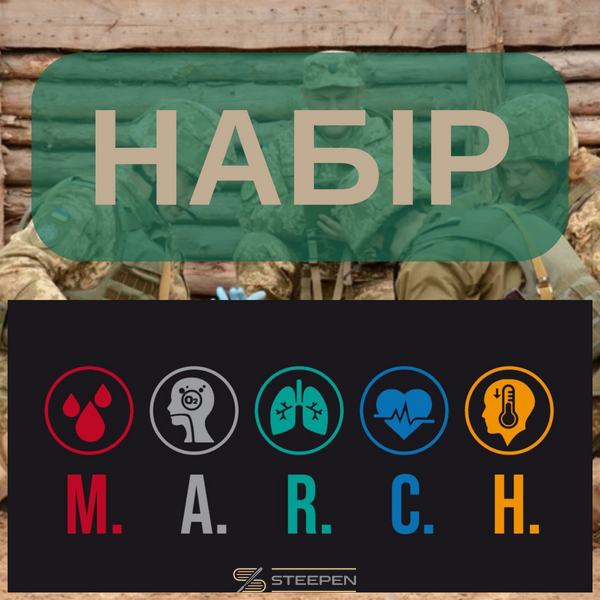|
Quantity
|
Out of stock
|
||
|
|
|||
Set of trainers for practicing emergency care skills according to the "MARCH" algorithm
We present a unique set of trainers that allow you to quickly and effectively master the skills of providing emergency care according to the M.A.R.C.H. algorithm. This configuration is ideal for first aid courses and tactical medicine training centers. All trainers are made of high-quality silicone, which guarantees their durability and ease of maintenance. This set will become an indispensable tool in your training activities!
Set contents:
1. For bleeding control:
- Trainer for controlling the correct application of a tourniquet – 2 pcs.
- Wound simulator with bleeding simulation – 1 pc.
- Bullet wound simulator with bleeding simulation – 1 pc.
- Trainer for wound channel packing – 1 pc.
- Trainer for wound channel packing in case of a bullet wound – Prof – 1 pc.
- Trainer for junctional bleeding control – 1 pc.
2. For airway patency restoration:
- Trainer for nasopharyngeal airway insertion – 1 pc.
- Trainer for cricothyrotomy – 1 pc.
3. For respiratory problems elimination:
- Trainer for needle decompression in case of tension pneumothorax – 1 pc.
4. For practicing intravenous injection skills:
- Trainer for peripheral intravenous catheter insertion – 1 pc.
- Trainer for intravenous injections "Start" – 2 pcs.
- Trainer for intravenous injections "Advanced" – 2 pcs.
- Trainer for subcutaneous injections – 1 pc.
5. Organizer bag:
- All trainers are packed in a specially designed organizer bag made of durable fabric for compact storage and convenient transportation.
Skills:
1. Massive Hemorrhage Control:
- Trainer for controlling the correct application of a tourniquet:
- Skills in applying a tourniquet to upper and lower extremities.
- Checking the correctness of tourniquet application for effective bleeding control.
- Wound simulator with bleeding simulation:
- Skills in identifying arterial and venous bleeding.
- Using bleeding control methods such as direct pressure and bandage application.
- Bullet wound simulator with bleeding simulation:
- Technique for stopping bleeding in penetrating wounds.
- Using wound packing methods to stop bleeding.
- Trainer for wound channel packing:
- Technique for packing deep wounds to stop arterial/venous bleeding.
- Using hemostatic gauze and regular gauze for packing.
- Trainer for wound channel packing in case of a bullet wound – Prof:
- Practicing packing techniques and controlling critical bleeding in bullet wounds.
- Trainer for junctional bleeding control:
- Technique for stopping junctional bleeding.
- Skills in applying special tourniquets for junctional bleeding.
2. Airway Control:
- Trainer for nasopharyngeal airway insertion:
- Practicing the technique of inserting a nasopharyngeal airway.
- Demonstrating the anatomical features of nasal passages and nasopharyngeal airway passage.
- Trainer for cricothyrotomy:
- Technique for performing surgical cricothyrotomy.
- Insertion of an endotracheal tube.
3. Respiratory Management:
- Trainer for needle decompression in case of tension pneumothorax:
- Technique for performing needle decompression to treat tension pneumothorax.
- Identifying anatomical landmarks for correct needle insertion.
- Controlling the correctness of the procedure.
4. Circulation (Intravenous injection skills):
- Trainer for peripheral intravenous catheter insertion:
- Technique for inserting a peripheral venous catheter.
- Using aseptic methods to prevent infections.
- Trainers for intravenous injections "Start" (2 pcs) and "Advanced" (2 pcs):
- Practicing intravenous injections.
- Using different methods of drug administration depending on complexity.
- Skills in recognizing venous anatomy and techniques for successful vein access.
- Trainer for subcutaneous injections:
- Practicing subcutaneous injection techniques.
- Using correct techniques for safe administration of medications into subcutaneous tissue.
General skills:
- Assessment and communication:
- Skills in assessing patient condition and action priorities.
- Effective communication with casualties.
- Psychological support and stability:
- Providing psychological support to patients in stressful situations.
- Ability to make quick decisions in critical conditions.
- Teamwork and coordination:
- Practicing teamwork during emergency situations.























